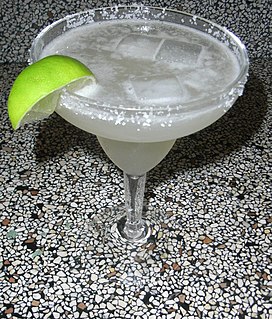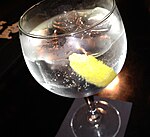
A margarita is a cocktail consisting of Tequila, triple sec, and lime juice often served with salt on the rim of the glass. The drink is served shaken with ice, blended with ice, or without ice. The drink is generally served in a stepped-diameter variant of a cocktail glass or champagne coupe called a margarita glass.

French 75 is a cocktail made from gin, champagne, lemon juice, and sugar. It is also called a 75 Cocktail, or in French simply a Soixante Quinze.

The sidecar is any cocktail traditionally made with cognac, orange liqueur, plus lemon juice. In its ingredients, the drink is perhaps most closely related to the older brandy crusta, which differs both in presentation and in proportions of its components.

The martini is a cocktail made with gin and vermouth, and garnished with an olive or a lemon twist. Over the years, the martini has become one of the best-known mixed alcoholic beverages. A popular variation, the vodka martini, uses vodka instead of gin for the cocktail's base spirit.

A Stinger is a duo cocktail made by adding crème de menthe to brandy. The cocktail's origins can be traced to the United States in the 1890s, and the beverage remained widely popular in America until the 1970s. It was seen as a drink of the upper class, and has had a somewhat wide cultural impact.

A sour is a traditional family of mixed drinks. Sours belong to one of the old families of original cocktails and are described by Jerry Thomas in his 1862 book How to Mix Drinks.

The Fine Art of Mixing Drinks is a book about cocktails by David A. Embury, first published in 1948. The book is noteworthy for its witty, highly opinionated and conversational tone, as well as its categorization of cocktails into two main types: aromatic and sour; its categorization of ingredients into three categories: the base, modifying agents, and special flavorings and coloring agents; and its 1:2:8 ratio for sour type cocktails.

A "fizz" is a mixed drink variation on the older sours family of cocktail. Its defining features are an acidic juice and carbonated water.

The Pink Lady is a classic gin-based cocktail with a long history. Its pink color is due to adding grenadine.

A Polar Bear, After Eight or Peppermint Paddy is a mint chocolate cocktail that tastes like a York Peppermint Pattie or an After Eight wafer. It is usually made from crème de cacao and peppermint schnapps, although crème de menthe is a popular substitute.
A breakfast martini is a marmalade cocktail with gin, marmalade, orange liqueur, and lemon juice, created by bartender Salvatore Calabrese.

The Aviation is a classic cocktail made with gin, maraschino liqueur, crème de violette, and lemon juice. Some recipes omit the crème de violette. It is served straight up, in a cocktail glass.
Harry MacElhone was an early 20th century bartender, most famous for his role at Harry's New York Bar in Paris, which he bought in 1923.

Mint lemonade is lemonade flavored with mint. It may be made with whole mint leaves, mint-flavored syrup, or pureed mint leaves, and may be served over ice cubes or blended with ice into a slush or smoothie. It is sometimes called a virgin mojito.
Takumi's Aviation is a modern classic cocktail made with gin, maraschino liqueur, Parfait d'Amour, and lemon juice. It is served straight up, in a cocktail glass.














